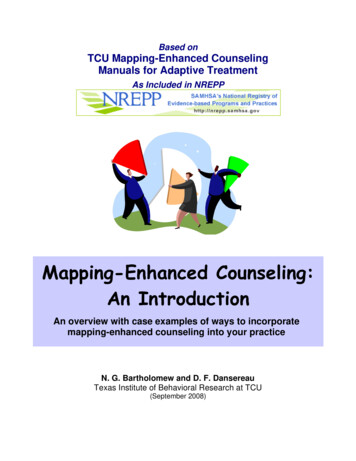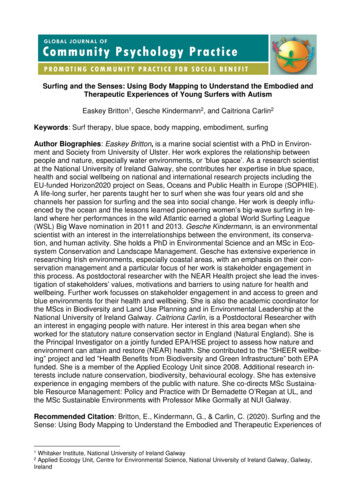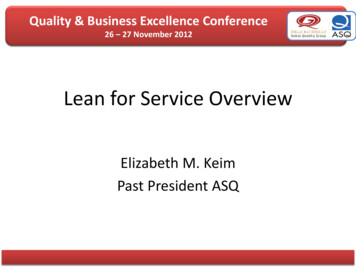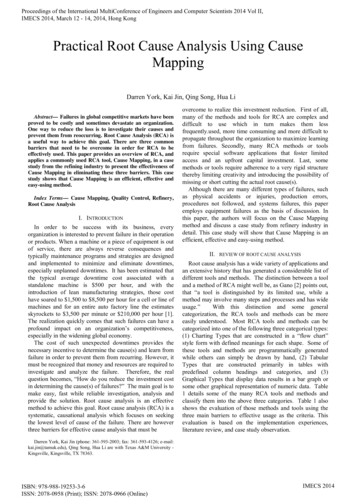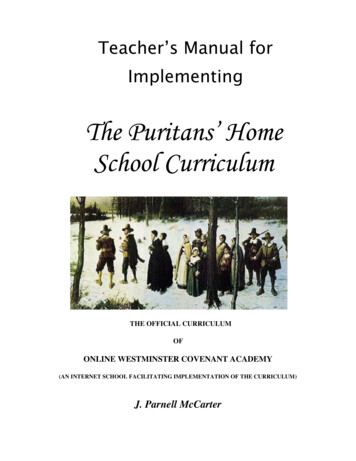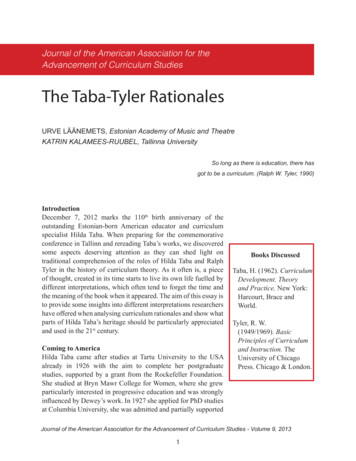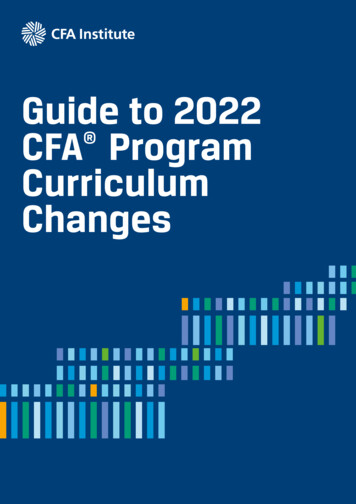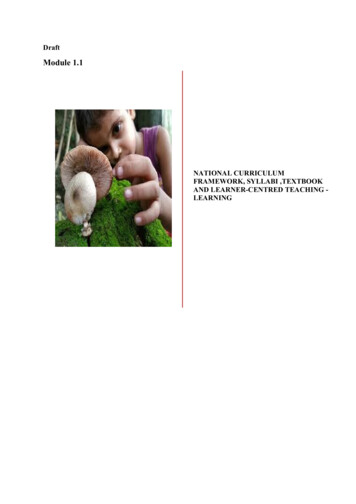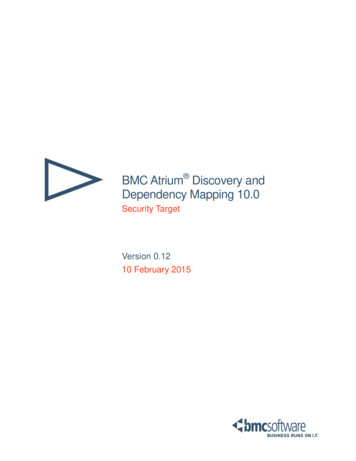
Transcription
Using Curriculum Mapping to Design,Scaffold and Assess Student LearningPresented by Dr. Laura Sáenz, Associate Provost for Assessment andContinuous Improvement2nd Annual Teaching Excellence Symposium, February 16, 2018
2What are the goals for the presentation? Define curriculum maps and curriculum mapping Describe how to use curriculum maps at the programlevel Describe how to use curriculum maps at the course level
3Focus Questions Do you know your program’s intended student learningoutcomes? Do you know the plan for assessing those outcomes? Do faculty regularly discuss the program’s student learningoutcomes? Have you considered how your course supports the overallprogram student learning outcomes?
4What is a curriculum map? Visual representation of the alignment between intendedlearning outcomes and opportunities to learn in the programor course. Collaboration tool Communication tool– With students– Among faculty
5What is the purpose for curriculum mapping? Curriculum mapping is a first step toward alignment ofteaching, learning, and assessment practices. Alignment refers to the linking of intended student learningoutcomes with the processes and practices needed to fosterthose outcomes. Not just a product, but a process!Hutchings, P. (2016). Aligning educational outcomes and practices. NILOA.
6A Word of Caution Curriculum mapping can easily become a superficialexercise overly focused on content coverage. Top-down– Driven by administration– Focused on accountability
7Effective Curriculum Mapping Process An effective curriculum mapping process engages faculty inidentifying learning opportunities that ensure mastery ofprogram outcomes. Bottom-up– Driven by faculty– Focused on evaluating where there are gaps in learningopportunities for students
8Curriculum-mapping at the Program Level Two-dimensional matrix representing core program coursesor experiences on one axis and outcomes on the otherCoursesCourse 1Course 2Course 3Course 4Course 5SLO 1SLO 2SLO 3
9Basic Curriculum Map: Undergraduate ProgramCore ProgramRequirements andExperiencesSLO 1SLO 2UTRGV 101XXUTRGV 201XUTRGV 301SLO 3SLO 4XXXXXUTRGV 401XXService learningXXX
10Basic Curriculum Map: Graduate ProgramCore ProgramRequirementsSLO 1: TheorySLO 2:CommunicationSLO 3: ResearchCoursesXXXQualifying ExamXOral ExamXDissertationXDissertation DefenseXXXXXXX
11Interdisciplinary Program: Curriculum MapBA English Core ProgramRequirementsEnglish Foundation ClusterLiterature ClusterLinguistics ClusterRhetorical Writing ClusterCreative Writing ClusterConcentrations Cluster:LiteratureSLO 1SLO 2SLO 3SLO 4SLO 5XXXXXXXXXX
12Balancing ActSLO 1SLO 2
13Questions to Consider1) How important is this SLO to the program?2) Is this an outcome that is more challenging to teach?3) Can this SLO be addressed effectively in fewer courses thanother SLOs require?
14Curriculum Maps: Level of EmphasisCore ProgramRequirements andExperiencesBlack/Primary:majority of contentaddresses SLOSLO 1SLO 2UTRGV 101XXUTRGV 201XUTRGV 301SLO 3SLO 4XXXXXUTRGV 401XXService learningXXXMediumGray/Secondary:Addressed by asignificant portionof the courseLight Gray/Tertiary:Addressedinfrequently or to aminor extentWhite/Nonexistent:Not addressed
15What’s wrong with this curriculum map?Core Program Requirementsand ExperiencesSLO 1SLO 2UTRGV 101XXUTRGV 201XUTRGV 301SLO 3SLO 4XXUTRGV 401XXService learningXXX
16What’s wrong with this curriculum map?Core ProgramRequirements andExperiencesSLO 1SLO 2UTRGV 101XXUTRGV 201XSLO 3SLO 4XXUTRGV 301UTRGV 401XXService learningXXXX
Scaffolding Teaching and LearningExperiences by Design through CurriculumMapping
18What is instructional scaffolding? Way of thinking about how to support students as they gofrom novice to expert.
19-More complex tasks-Less complex tasks-Less foundationalknowledge-More foundationalknowledge-Limited ncesLess supportMore supportWhat kind of support do students need?
20Using Curriculum Maps to Scaffold Instruction by Skill LevelCurriculum maps can be used to help determine how the curriculum systematicallybuilds skills and knowledge.Stage 1:Students areintroduced tocontentStage 2:Content isreinforcedStage 3:Opportunitiesfor mastery areprovidedStage 4:Mastery isassessed
21From Introduction to MasteryRequirements andExperiencesI IntroducedSLO 1SLO 2UTRGV 101IIUTRGV 202RSLO 3IIUTRGV 301RUTRGV 401MRM&AMM&AUTRGV 404E-PortfolioMM&ASLO 4RMM&AR Reinforced/PracticedM MasteredA Assessed forProgramassessment
22On Your Own: Scaffolding Assessment TasksIntroduction to MasteryRequirementsand ExperiencesUTRGV 101UTRGV 202UTRGV 301UTRGV 401UTRGV 404E-PortfolioI IntroducedSLO 1SLO 2Note: Refer to slide 21SLO 3SLO 4R Reinforced/PracticedM MasteredA Assessed forProgramassessmentEQS Short AnswerExam questionsEQMC Multiple-choiceExam QuestionsS Standardized TestPO PortfolioO Oral PresentationP PaperI InternshipL Lab
23On Your Own: Scaffolding Learning OpportunitiesIntroduction to MasteryRequirements& ExperiencesI IntroducedSLO 1SLO 2SLO 3SLO 4R Reinforced/PracticedM MasteredUTRGV 101A Assessed forProgramassessmentUTRGV 202UTRGV 301Learning Opportunities:1. Readings2. Videos3. Group Discussions4. Teamwork5. Project-based learningUTRGV 4016. LecturesUTRGV 404E-Portfolio7. DemonstrationsNote: Refer to slide 218. Class Discussions
24Learning Opportunities WorksheetProgram Student LearningOutcome (one outcome t:Key Assignments and ing Experience/activity:Learning Experience/activity:Learning Experience/activity:How does this learningexperience/activity help studentslearn this SLO?How does this learningexperience/activity help studentslearn this SLO?How does this learningexperience/activity help studentslearn this SLO?How is this an introductory level oflearning opportunity for this SLO?How is this a reinforced/practiced level How is this a mastery level oflearning opportunity for this SLO?learning opportunity for this SLO?
Curriculum Maps and Taxonomies of Learning25
26Scaffolding through Taxonomies of LearningRequirements andExperiencesSLO 1UTRGV 101UTRGV 202SLO 2SLO 3R, UAP, ANR, UR, UUTRGV 301AP, ANUTRGV 401EAP, ANE&CEE&CUTRGV 404E-PortfolioEE&CSLO 4R RememberU UnderstandAP ApplyAN AnalyzeAP, ANEE&CE EvaluateC Create
27On Your Own: Scaffolding Assessment TasksR RememberRequirements& ExperiencesSLO 1SLO 2SLO 3SLO 4U UnderstandAP ApplyUTRGV 101AN AnalyzeUTRGV 202E EvaluateUTRGV 301C CreateEQS Short AnswerExam questionsEQMC Multiple-choiceExam QuestionsS Standardized TestPO PortfolioO Oral PresentationUTRGV 401P PaperUTRGV 404E-PortfolioI InternshipNote: Refer to slide 26L Lab
28On Your Own: Scaffolding Learning OpportunitiesRequirements &ExperiencesUTRGV 101UTRGV 202UTRGV 301UTRGV 401UTRGV 404E-PortfolioR RememberSLO 1SLO 2SLO 3SLO 4U UnderstandLearning Opportunities:1. ReadingsAP Apply2. VideosAN Analyze3. Group DiscussionsE Evaluate4. TeamworkC Create5. Project-based learning6. Lectures7. Demonstrations8. Class Discussions
29How does your course support the program’s studentlearning outcomes?Course Number/Title:Course SLOCourseassessment orassignment forSLOLevel oflearning/cognitiveProgram SLO Level ofLevel of Skill processthe course Emphasis(Introduced, (Remember,SLOCourse learning(Primary,Reinforced/Pr Understand,Apply, Analyze,experience or activity contributes Secondary, or acticed,Evaluate, Create)for SLOtoTertiary)Mastery)
30Thank you!For Questions:Email: laura.saenz@utrgv.edu
What is the purpose for curriculum mapping? Curriculum mapping is a first step toward alignment of teaching, learning, and assessment practices. Alignment refers to the linking of intended student learning outcomes with the processes and practices needed to foster those outcomes.

